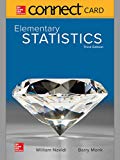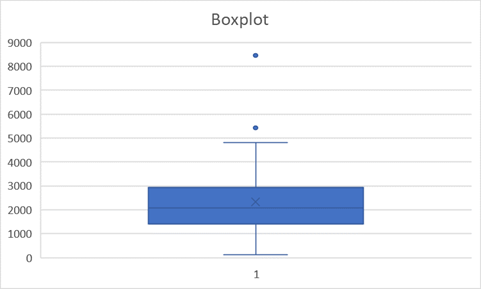
Concept explainers
a)
To find the first and third
a)
Answer to Problem 38E
First quartile = 1414.75 and third quartile = 2931
Explanation of Solution
Formula:
First quartile Q1:
Third quartile Q3:
Calculation:
Data sorted in ascending order:
| 135 | 1229 | 1658 | 2128 | 2486 | 3843 |
| 559 | 1339 | 1686 | 2155 | 2561 | 3968 |
| 700 | 1359 | 1704 | 2166 | 2831 | 4055 |
| 984 | 1366 | 1730 | 2218 | 2915 | 4392 |
| 1090 | 1431 | 1803 | 2273 | 2979 | 4472 |
| 1127 | 1433 | 1808 | 2320 | 3329 | 4809 |
| 1128 | 1507 | 1880 | 2321 | 3336 | 5434 |
| 1176 | 1526 | 2015 | 2395 | 3375 | 8460 |
| 1177 | 1592 | 2071 | 2427 | 3637 | |
| 1211 | 1598 | 2096 | 2459 | 3672 | |
Here, n = 58
First need to find First quartile and third quartile
First Quartile:
First quartile is 1414.75
Third quartile:
Third quartile is 2931.
b)
To find
b)
Answer to Problem 38E
Median is 2083.5
Explanation of Solution
Formula:
Calculation:
c)
To find upper and lower outlier boundaries.
c)
Answer to Problem 38E
Lower outlier boundary is -859.625
Upper outlier boundary is 5205.375
Explanation of Solution
Formula:
IQR:
Calculation:
Therefore,
d)
To find the 135 and 559 are outliers or not.
d)
Answer to Problem 38E
135 and 559 are not outliers.
Explanation of Solution
Outliers are those values which are less than Q1-1.5 x IQR and greater than Q3+1.5 x IQR.
Here,
Lower outlier boundary is -859.625
Upper outlier boundary is 5205.375
135 and 559 are within
e)
To find the 8460 and 5434 are outliers or not.
e)
Answer to Problem 38E
The 8460 and 5434 are outliers.
Explanation of Solution
Outliers are those values which are less than Q1-1.5 x IQR and greater than Q3+1.5 x IQR.
Here,
Lower outlier boundary is -859.625
Upper outlier boundary is 5205.375
8460 and 5434 are greater than upper outlier limit 5205.375. Hence both are outliers.
f)
To construct a boxplot from given data
f)
Explanation of Solution
Boxplot from given data:

g)
To find shape of the distribution
g)
Answer to Problem 38E
The shape of the distribution is positively-skewed.
Explanation of Solution
Here, median is close to first quartile. Hence the shape of the distribution is positively-skewed.
h)
To find 15st percentile
h)
Answer to Problem 38E
15st percentile is 1176.85
Explanation of Solution
Therefore,
i)
To find 65th percentile
i)
Answer to Problem 38E
65th percentile is 2406.2
Explanation of Solution
Therefore,
j)
To find percentile rank for 1433 words
j)
Answer to Problem 38E
Percentile rank for 1433 words is 25.86%
Explanation of Solution
Formula:
Calculation:
Want to see more full solutions like this?
Chapter 3 Solutions
Connect Hosted by ALEKS Access Card or Elementary Statistics
- You are provided with data that includes all 50 states of the United States. Your task is to draw a sample of: o 20 States using Random Sampling (2 points: 1 for random number generation; 1 for random sample) o 10 States using Systematic Sampling (4 points: 1 for random numbers generation; 1 for random sample different from the previous answer; 1 for correct K value calculation table; 1 for correct sample drawn by using systematic sampling) (For systematic sampling, do not use the original data directly. Instead, first randomize the data, and then use the randomized dataset to draw your sample. Furthermore, do not use the random list previously generated, instead, generate a new random sample for this part. For more details, please see the snapshot provided at the end.) Upload a Microsoft Excel file with two separate sheets. One sheet provides random sampling while the other provides systematic sampling. Excel snapshots that can help you in organizing columns are provided on the next…arrow_forwardThe population mean and standard deviation are given below. Find the required probability and determine whether the given sample mean would be considered unusual. For a sample of n = 65, find the probability of a sample mean being greater than 225 if μ = 224 and σ = 3.5. For a sample of n = 65, the probability of a sample mean being greater than 225 if μ=224 and σ = 3.5 is 0.0102 (Round to four decimal places as needed.)arrow_forward***Please do not just simply copy and paste the other solution for this problem posted on bartleby as that solution does not have all of the parts completed for this problem. Please answer this I will leave a like on the problem. The data needed to answer this question is given in the following link (file is on view only so if you would like to make a copy to make it easier for yourself feel free to do so) https://docs.google.com/spreadsheets/d/1aV5rsxdNjHnkeTkm5VqHzBXZgW-Ptbs3vqwk0SYiQPo/edit?usp=sharingarrow_forward
- The data needed to answer this question is given in the following link (file is on view only so if you would like to make a copy to make it easier for yourself feel free to do so) https://docs.google.com/spreadsheets/d/1aV5rsxdNjHnkeTkm5VqHzBXZgW-Ptbs3vqwk0SYiQPo/edit?usp=sharingarrow_forwardThe following relates to Problems 4 and 5. Christchurch, New Zealand experienced a major earthquake on February 22, 2011. It destroyed 100,000 homes. Data were collected on a sample of 300 damaged homes. These data are saved in the file called CIEG315 Homework 4 data.xlsx, which is available on Canvas under Files. A subset of the data is shown in the accompanying table. Two of the variables are qualitative in nature: Wall construction and roof construction. Two of the variables are quantitative: (1) Peak ground acceleration (PGA), a measure of the intensity of ground shaking that the home experienced in the earthquake (in units of acceleration of gravity, g); (2) Damage, which indicates the amount of damage experienced in the earthquake in New Zealand dollars; and (3) Building value, the pre-earthquake value of the home in New Zealand dollars. PGA (g) Damage (NZ$) Building Value (NZ$) Wall Construction Roof Construction Property ID 1 0.645 2 0.101 141,416 2,826 253,000 B 305,000 B T 3…arrow_forwardRose Par posted Apr 5, 2025 9:01 PM Subscribe To: Store Owner From: Rose Par, Manager Subject: Decision About Selling Custom Flower Bouquets Date: April 5, 2025 Our shop, which prides itself on selling handmade gifts and cultural items, has recently received inquiries from customers about the availability of fresh flower bouquets for special occasions. This has prompted me to consider whether we should introduce custom flower bouquets in our shop. We need to decide whether to start offering this new product. There are three options: provide a complete selection of custom bouquets for events like birthdays and anniversaries, start small with just a few ready-made flower arrangements, or do not add flowers. There are also three possible outcomes. First, we might see high demand, and the bouquets could sell quickly. Second, we might have medium demand, with a few sold each week. Third, there might be low demand, and the flowers may not sell well, possibly going to waste. These outcomes…arrow_forward
- Consider the state space model X₁ = §Xt−1 + Wt, Yt = AX+Vt, where Xt Є R4 and Y E R². Suppose we know the covariance matrices for Wt and Vt. How many unknown parameters are there in the model?arrow_forwardBusiness Discussarrow_forwardYou want to obtain a sample to estimate the proportion of a population that possess a particular genetic marker. Based on previous evidence, you believe approximately p∗=11% of the population have the genetic marker. You would like to be 90% confident that your estimate is within 0.5% of the true population proportion. How large of a sample size is required?n = (Wrong: 10,603) Do not round mid-calculation. However, you may use a critical value accurate to three decimal places.arrow_forward
- 2. [20] Let {X1,..., Xn} be a random sample from Ber(p), where p = (0, 1). Consider two estimators of the parameter p: 1 p=X_and_p= n+2 (x+1). For each of p and p, find the bias and MSE.arrow_forward1. [20] The joint PDF of RVs X and Y is given by xe-(z+y), r>0, y > 0, fx,y(x, y) = 0, otherwise. (a) Find P(0X≤1, 1arrow_forward4. [20] Let {X1,..., X} be a random sample from a continuous distribution with PDF f(x; 0) = { Axe 5 0, x > 0, otherwise. where > 0 is an unknown parameter. Let {x1,...,xn} be an observed sample. (a) Find the value of c in the PDF. (b) Find the likelihood function of 0. (c) Find the MLE, Ô, of 0. (d) Find the bias and MSE of 0.arrow_forwardarrow_back_iosSEE MORE QUESTIONSarrow_forward_ios
 Glencoe Algebra 1, Student Edition, 9780079039897...AlgebraISBN:9780079039897Author:CarterPublisher:McGraw Hill
Glencoe Algebra 1, Student Edition, 9780079039897...AlgebraISBN:9780079039897Author:CarterPublisher:McGraw Hill Big Ideas Math A Bridge To Success Algebra 1: Stu...AlgebraISBN:9781680331141Author:HOUGHTON MIFFLIN HARCOURTPublisher:Houghton Mifflin Harcourt
Big Ideas Math A Bridge To Success Algebra 1: Stu...AlgebraISBN:9781680331141Author:HOUGHTON MIFFLIN HARCOURTPublisher:Houghton Mifflin Harcourt Holt Mcdougal Larson Pre-algebra: Student Edition...AlgebraISBN:9780547587776Author:HOLT MCDOUGALPublisher:HOLT MCDOUGAL
Holt Mcdougal Larson Pre-algebra: Student Edition...AlgebraISBN:9780547587776Author:HOLT MCDOUGALPublisher:HOLT MCDOUGAL



